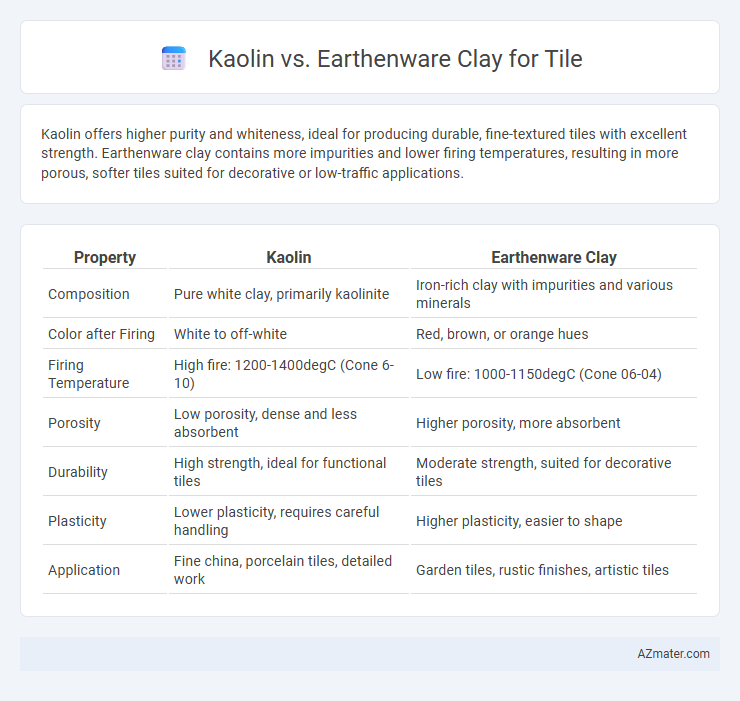Kaolin offers higher purity and whiteness, ideal for producing durable, fine-textured tiles with excellent strength. Earthenware clay contains more impurities and lower firing temperatures, resulting in more porous, softer tiles suited for decorative or low-traffic applications.
Table of Comparison
| Property | Kaolin | Earthenware Clay |
|---|---|---|
| Composition | Pure white clay, primarily kaolinite | Iron-rich clay with impurities and various minerals |
| Color after Firing | White to off-white | Red, brown, or orange hues |
| Firing Temperature | High fire: 1200-1400degC (Cone 6-10) | Low fire: 1000-1150degC (Cone 06-04) |
| Porosity | Low porosity, dense and less absorbent | Higher porosity, more absorbent |
| Durability | High strength, ideal for functional tiles | Moderate strength, suited for decorative tiles |
| Plasticity | Lower plasticity, requires careful handling | Higher plasticity, easier to shape |
| Application | Fine china, porcelain tiles, detailed work | Garden tiles, rustic finishes, artistic tiles |
Introduction to Kaolin and Earthenware Clays
Kaolin, a pure, white clay rich in kaolinite, is prized for its high plasticity and resistance to firing, making it ideal for smooth, durable tile surfaces. Earthenware clay, composed of iron-rich minerals, fires at lower temperatures and offers a porous, rustic texture often favored in traditional tile designs. Understanding the distinct mineral compositions and firing properties of kaolin and earthenware clays is essential for selecting the appropriate material for tile manufacturing and finishing.
Chemical Composition Differences
Kaolin clay primarily consists of the mineral kaolinite, composed of aluminum silicate (Al2Si2O5(OH)4) with a high purity of silica and alumina, resulting in a white firing body ideal for fine ceramics and tiles. Earthenware clay contains higher levels of iron oxides (Fe2O3) and other impurities like calcium and magnesium, which give it a reddish or brown color and lower firing temperatures compared to kaolin. The chemical composition differences influence the tile's strength, color, and porosity, with kaolin tiles exhibiting greater whiteness and durability, while earthenware tiles tend to be more porous and absorbent.
Physical Properties Comparison
Kaolin clay exhibits fine particle size and low impurities, resulting in high plasticity, smooth texture, and excellent firing strength, making it ideal for producing uniform, dense tiles with minimal shrinkage. Earthenware clay contains higher iron and alumina content, which lowers firing temperature but results in more porous, less durable tiles with greater brittleness and higher water absorption. The physical properties of kaolin provide superior hardness and resistance to wear compared to the more porous and softer nature of earthenware tiles.
Color and Texture Outcomes
Kaolin clay produces tiles with a bright white color and smooth, uniform texture, making it ideal for achieving crisp, vibrant glazes and intricate designs. Earthenware clay typically results in warmer hues, such as reds, oranges, and browns, with a more porous, coarse texture that adds rustic character to tiles. The choice between Kaolin and Earthenware significantly affects the final aesthetic, with Kaolin offering a refined finish and Earthenware providing natural, earthy tones and tactile variation.
Firing Temperatures and Processes
Kaolin clay typically requires higher firing temperatures between 1200degC and 1400degC, making it suitable for porcelain and vitrified tile production due to its low impurity and high purity content. Earthenware clay, fired at lower temperatures ranging from 1000degC to 1150degC, results in a more porous, less dense tile that remains slightly more absorbent and softer than kaolin-based tiles. The firing process for kaolin clay involves precise temperature control to achieve its characteristic hardness and translucency, while earthenware clay firing allows for quicker cycles and is often used for decorative or rustic tile styles.
Durability and Strength Analysis
Kaolin clay offers superior strength and durability for tile production due to its high purity and fine particle size, resulting in dense, hard-fired ceramics resistant to chipping and wear. Earthenware clay, while easier to work with and more porous, generally produces tiles with lower mechanical strength and higher water absorption, making them less durable in high-traffic or outdoor applications. The vitrification temperature and mineral composition differences between kaolin and earthenware clays significantly impact tile longevity and resistance to physical stress.
Water Absorption Rates
Kaolin clay features a low water absorption rate, typically below 5%, making it ideal for producing dense, durable tiles with minimal porosity. Earthenware clay generally exhibits higher water absorption, ranging from 5% to 15%, resulting in more porous tiles that may require glazing for moisture resistance. Understanding these absorption differences is critical for selecting the appropriate clay type based on tile durability and water exposure requirements.
Suitability for Tile Applications
Kaolin clay offers superior whiteness, smooth texture, and high firing temperature, making it ideal for producing durable, fine-textured tiles with excellent strength and resistance to wear. Earthenware clay, characterized by its porous nature and lower firing temperature, is more suitable for decorative or low-traffic tile applications where moisture resistance is less critical. The high purity and refractory properties of kaolin make it preferred for functional tiles requiring long-term durability in both commercial and residential settings.
Cost and Availability Factors
Kaolin clay typically costs more than earthenware clay due to its higher purity and specialized processing, making it less economical for large-scale tile production. Earthenware clay is widely available and more affordable, often sourced locally, which reduces shipping expenses and supply chain complexity. The abundance and lower price of earthenware clay make it a preferred choice for budget-friendly tile manufacturing projects.
Sustainability and Environmental Impact
Kaolin clay, a fine white clay, offers a more sustainable option for tile production due to its higher purity and lower energy requirement in firing compared to earthenware clay, which contains more impurities and requires lower firing temperatures but may release more pollutants. The extraction process of kaolin is generally less disruptive to the environment, while earthenware clay sourcing can lead to greater soil degradation and habitat disturbance. Choosing kaolin for tiles supports longevity and recyclability, contributing to reduced environmental impact over the product lifecycle.

Infographic: Kaolin vs Earthenware Clay for Tile
 azmater.com
azmater.com